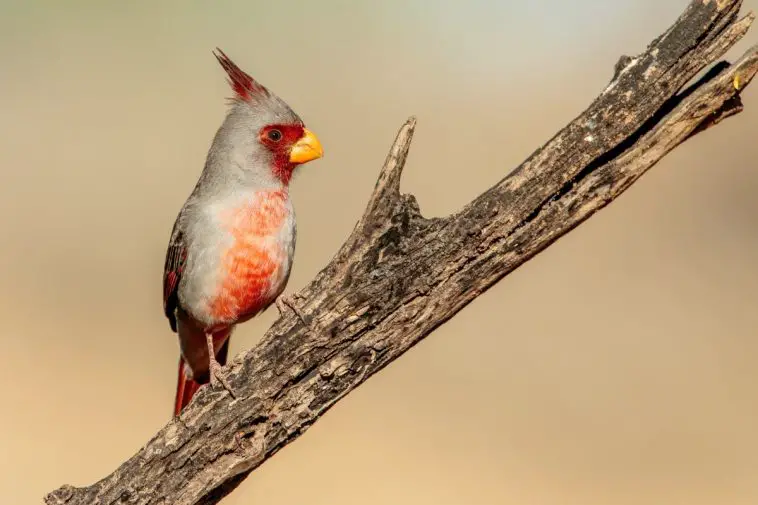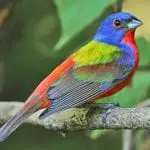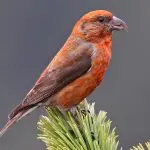Scientific Facts
| Common Name | Pyrrhuloxia |
| Scientific Name | Cardinalis sinuatus |
| Lifespan | 8 Years |
| Size | 8.3 inches |
| Mass | 0.8 – 1.5 oz. |
| Habitat | Mesquite thickets, desert scrub, along stream beds |
| Range | The American Southwest, northern Mexico |
Information & Physical Appearance
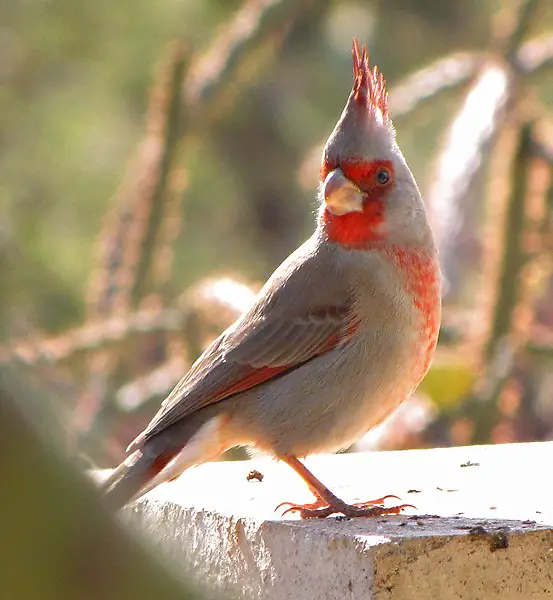
Scientifically referred to as Cardinalis sinuatus, another common name for the Pyrrhuloxia is a desert cardinal. This bird species belongs to the order Passeriformes, the family Cardinalidae.
Other bird species in the family Cardinalidae include the summer tanager, the hepatic tanager, the western tanager, the scarlet tanager, the rose-breasted grosbeak, the Northern cardinal, the black-headed grosbeak, the lazuli bunting, the blue grosbeak, the varied bunting, the indigo bunting, the dickcissel, and the painted bunting.
The desert cardinal resembles most closely the Northern Cardinal and the Vermillion cardinal, as all of these bird species belong to the same genus, namely the Cardinalis genus.
Pyrrhuloxias are medium-sized songbirds. They are larger than the Black-throated sparrow, yet about the same size as the Northern cardinal, reaching up to 8.3 inches in length and a body mass of up to 1.5 oz.
These birds are stocky and are characterized by long tails and tall crests. Their parrot-like bills are short, rounded, and quite heavy, with a curved upper edge (aka culmen), that is perfectly suited to cracking the seeds they feed with.
Overall, desert cardinals are gray-brown to gray birds, displaying prominent flashes of vivid red.
Adult male pyrrhuloxias are “equipped” with a tall crest highlighted in red. Splashes of red are also noticeable on the wings and on the long tail, while the overall body coloration is crisp gray. The belly stripe, as well as the face mask, are also redliving.
Adult female pyrrhuloxias differ from males mainly because of the absence of a red face mask. Also, females are less red as compared with males. The females, just like males, display highlighted red coloration on the tail, crest, and wings, with an overall buffy grayish body coloration.
In both sexes, the bill is yellow.
Immature pyrrhuloxias pretty much resemble the appearance of adult females. However, the young desert cardinals have fewer red markings, and their bills are dark gray in color.
Lifespan
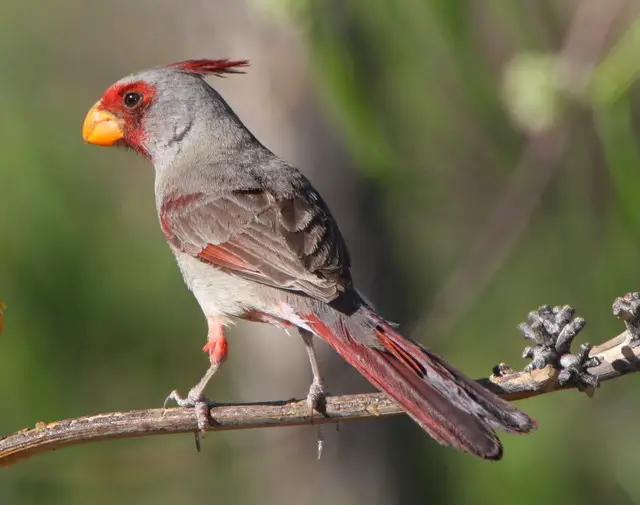
According to the Animal Ageing and Longevity Database, up-to-date, the maximum longevity of Pyrrhuloxias has not been established yet.
The oldest desert cardinal ever recorded was at least 8 years and 1 month of age. The specimen was recaptured and then re-released into the wild during banding operation that took place in Arizona. Also, the oldest known Pyrrhuloxia was male.
Although this bird species have been reported to live up to 8.1 years in the wild, it is possible for the maximum longevity to be significantly longer, and hence, quite underestimated as of now, mainly due to the lack of in-depth research and further observations on that matter.
Ecosystem & Habitat
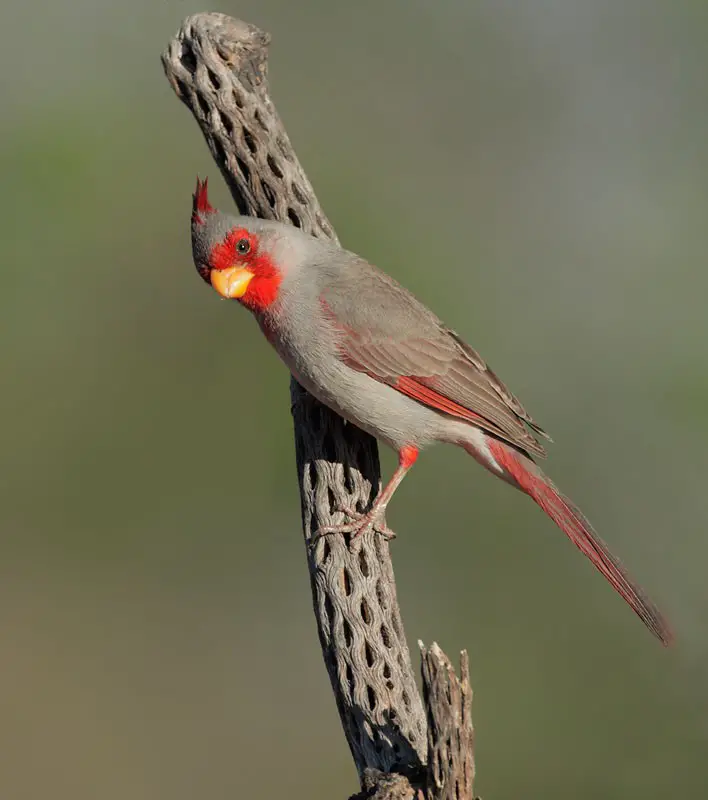
Pyrrhuloxias are distributed across several U.S. States, namely New Mexico, Texas, Arizona, and Mexico, where these birds are year-round residents.
In particular, these birds are known to occupy the southeastern parts of Arizona, the southwestern half of Texas, as well as the southern portion of New Mexico.
Pyrrhuloxias’ range spans across Mexico’s west to the east coast, all the way in the north to Isthmus of Tehuantepec, Sierra Madre del Sur, and the Trans-Mexican Volcanic belt. These birds do not occur in the Sierra Madre Occidental, though.
Ultimately, the pyrrhuloxia is considered relatively non-migratory. However, although only occasionally, this bird species may choose to stray a bit north of its normal range.
The preferred type of habitat includes the zones located along stream beds.
Pyrrhuloxias can be found in streamside woodlands, upland deserts, desert scrublands, farm fields characterized by hedgerows, mesquite savannas, and, nonetheless, residential areas located close to mesquite.
Outside of the breeding season, some Pyrrhuloxias are known to wander into urban habitats, too, as well as into riparian habitats (cottonwood and sycamore), and mesquite-hackberry habitats.
Food & Diet
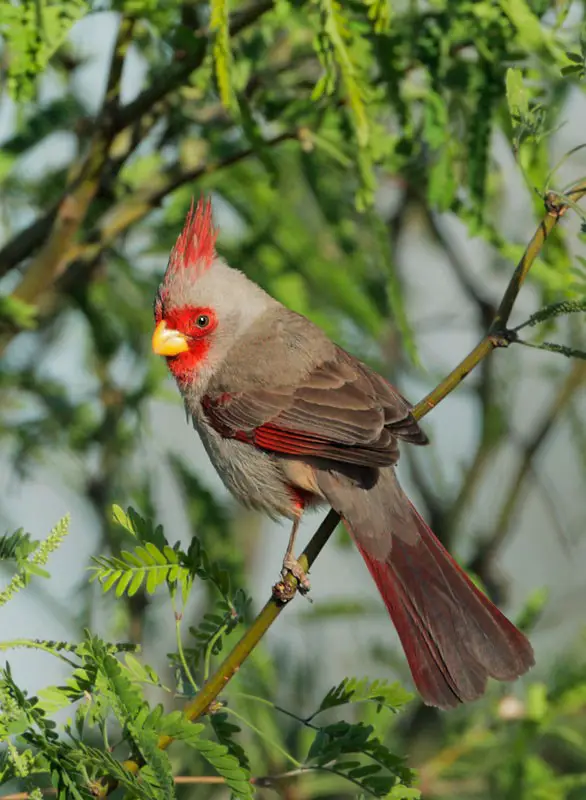
The Pyrrhuloxia is an omnivorous bird. It is an opportunistic feeder that spends a huge amount of its time engaged in foraging in the shrubbery, as well as on the ground, looking for fruits, seeds, and large insects to feast on.
This bird species is known to glean seeds from various plants, such as sorghum, doveweed, thistle grass, yellow foxtail, crabgrass, sandbur, spurge, panicum, joint grass, wiregrass, crabgrass, and pigweed.
Even though the Pyrrhuloxia eats a significantly smaller amount of fruit as compared with its close relative – the Northern cardinal – some of the fruits in its diet include elderberries, nightshade fruit, and cactus fruits.
In addition to eating cactus fruits, the pyrrholuxia does also feeds on blooming saguaro cacti. It is suggested that the saguaro cacti’s flowers’ pollen and nectar are consumed.
When it comes to living prey, the pyrrhuloxia is to catch beetles, cicadas, grasshoppers, stinkbugs, caterpillars, cotton cutworms, and nonetheless, weevils. It is from trees where the desert cardinal snatches insects. Meanwhile, the seeds are mostly picked from the preferred plants’ stalks.
Bird feeders are also visited by the pyrrhuloxia for feeding purposes. In the winter, this bird species are known to forage in flocks consisting of a great number of birds, sometimes thousands.
Behavior
During the breeding season, Pyrrhuloxias use songs in order to establish, as well as to defend, their breeding territories. It is up until the end of the breeding season, which takes place at some point in late summer when pyrrhuloxias stop being aggressively territorial.
Becoming vocally and fiercely territorial as soon as the time for breeding kicks in, pyrrhuloxias do forget their disputes and become much calmer during the winter when they join together for the purpose of forming large foraging flocks.
By alternating a glide and a few wingbeats, these birds have an undulating flight pattern, making mostly short flights.
Forming mixed flocks, desert cardinals are to actively forage for seeds during the fall and during the winter season. It is in late February – early Marchdove weed when the breeding males become aggressive, and the flocks gradually begin to fall apart.
After establishing their breeding territory, pyrrhuloxias are to further patrol the boundaries. They sing at prominent perches, thus, warning and chasing away possible intruders.
The courtship behavior of males is not as lavish as that of other bird species. They court the females by first giving a distinct call. Next, the male is to approach the female with a sound of wing fluttering. Then, he is to bow his head, and sometimes, he may also offer a piece of food to the female.
As soon as nests are already in progress, females are known to join their male mates when it comes to chasing away intruders.
Up-to-date, it remains largely a mystery whether mating pairs continue their relationship year after year. The mates are known to possible stay together year-round, though.
Reproduction
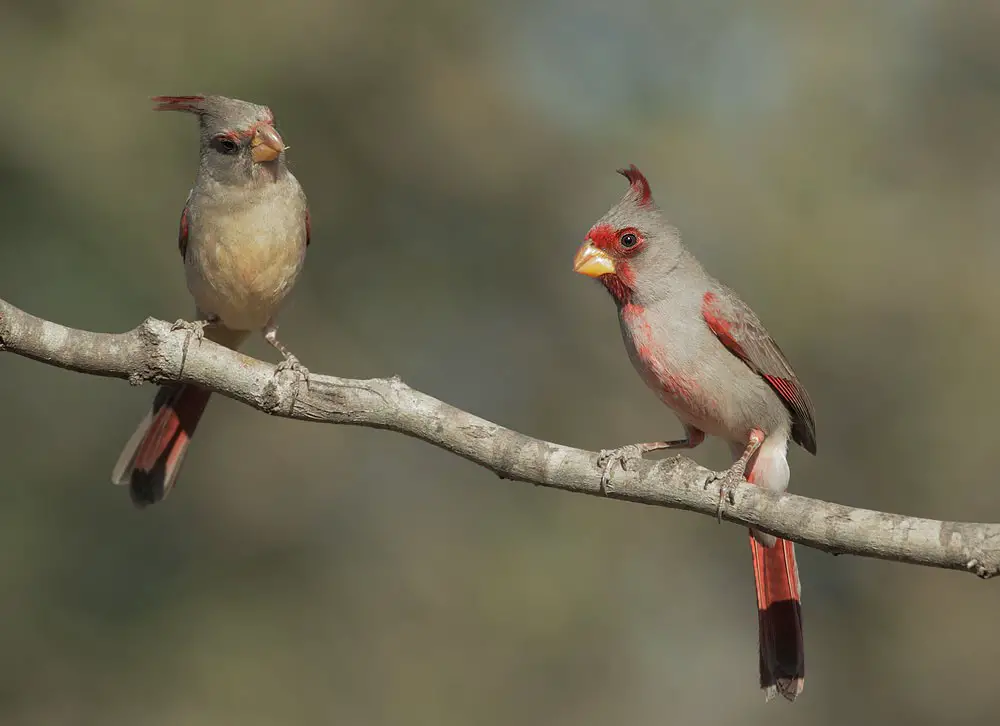
- The breeding season for the pyrrhuloxia typically starts in mid-March and ends in the middle of August.
- It is males to establish breeding territories with the approach of the breeding season, and males are the ones to defend these territories by chasing away unwanted intruders and choosing a suitable vantage point for singing.
- Desert cardinals build their nests in a dense shrub. In most cases, the nest is well-concealed in the brush, such as a gray thorn, paloverde, mesquite, or elderberry. As compared with Northern cardinals, desert cardinals choose to nest in significantly more open habitats.
- The compact, neat nest is usually placed at 5 and up to 15 feet off the ground. It rests quite insecurely on small, fine twigs located away from the main branches of the tree and the trunk itself.
- The shape of the small-sized nest is cup-like. The outer cup is constructed out of thorny twigs, coarse grass, and pieces of tree bark by the female. The nest measures 1.5 inches deep and 3 inches across. On the inside, the nest is lined with horsehair, plant fibers, rootles, spiderwebs, strips of bark, tiny plant stems, and feathers.
- All of the nesting materials are gathered by the female.
- Pyrrhuloxias can produce only a single one or two broods per year.
- The clutch consists of two and up to four eggs. The eggs are whitish in color, speckled with gray or green, and quite similar in appearance to the eggs of the Northern cardinal. The desert cardinal’s egg is 0.8 and up to 1.1 inches in length and 0.6 – 0.8 inches in width.
- The incubation period lasts for about 14 days. Within this period, it is the male’s responsibility to bring food to the female.
- Chicks are helpless at hatching. They have bright yellow bills, lined with red around the mouth zone.
- It takes about 10 days for the chicks to fledge, with both the female and the male pyrrhuloxias sharing parental care for their young.
- Before fully fledging, the young desert cardinals may require up to a full month. Once fully fledges, the young become independent and begin feeding in large flocks. It is during this particular period that the young will grow completely.
Health Risks, Survival Threats & Conservation

All throughout the world, avian diseases and illnesses are sometimes widespread in birds and are always present. The pyrrhuloxia is no exception.
Some of the possible diseases and parasites may be hosted on or within the birds permanently. Other possible diseases and parasites may be hosted only for a short amount of time.
Unfortunately, some of these diseases are fatal to the bird host. In some cases, pyrrhuloxias, just like other bird and animal species alike, may only become infected with a particular disease without dying, but instead, acting as carriers of the diseases. This is especially dangerous as a disease can easily spread to other birds within the population, possibly causing outbreaks.
Most diseases can be summed up to several common origins, namely fungal sources, parasites, bacteria, or viruses. The disease can be internal or external.
Up-to-date, large areas of the desert cardinal’s habitat, more specifically, in its northern range, have been progressively becoming lost to humans. The former populations of pyrrhuloxia in these areas are estimated to have undergone a slight decline.
More precisely, the 20th-century decline is associated with the millions of acres of desert scrubland that were cleared for both urbanization and agricultural purposes alike in the Southwest.
Between 1966 and 2014, the desert cardinal populations declined by 1.5% per year. According to the North American Breeding Bird Survey, the yearly decline of 1.5% has resulted in an overall decline of 53%.
Based on data provided by Partners in Flight, the global breeding population of pyrrhuloxia consists of 3 million birds.
63% of the desert cardinals are known to live. in Mexico. 37% of these birds are found in the U.S.
On the Continental Concern Score, pyrrhuloxias are rated 12 out of 20. Also, they are U.S. – Canada Stewardship Species.
However, the desert cardinal was not part of the 2014 State of Birds Watch List.
The pyrrhuloxia is listed as Least Concern on the IUCN Red List of Threatened Species. Based on the global 2016 assessment, the population trend was estimated to decrease. The population is not severely fragmented, though.
Fortunately, at least some of the natural habitat of Cardinalis sinuatus is safeguarded within various protected areas, such as national wildlife parks and refugees alike. Apart from occurring in at least one protected area, the species is subjected to a systematic monitoring scheme.
Some of the natural predators of desert cardinals and their eggs include Greater roadrunners, Ferruginous Pygmy-Owls, as well as domestic and feral cats, among others.
Availability – Where to Get a Pyrrhuloxia
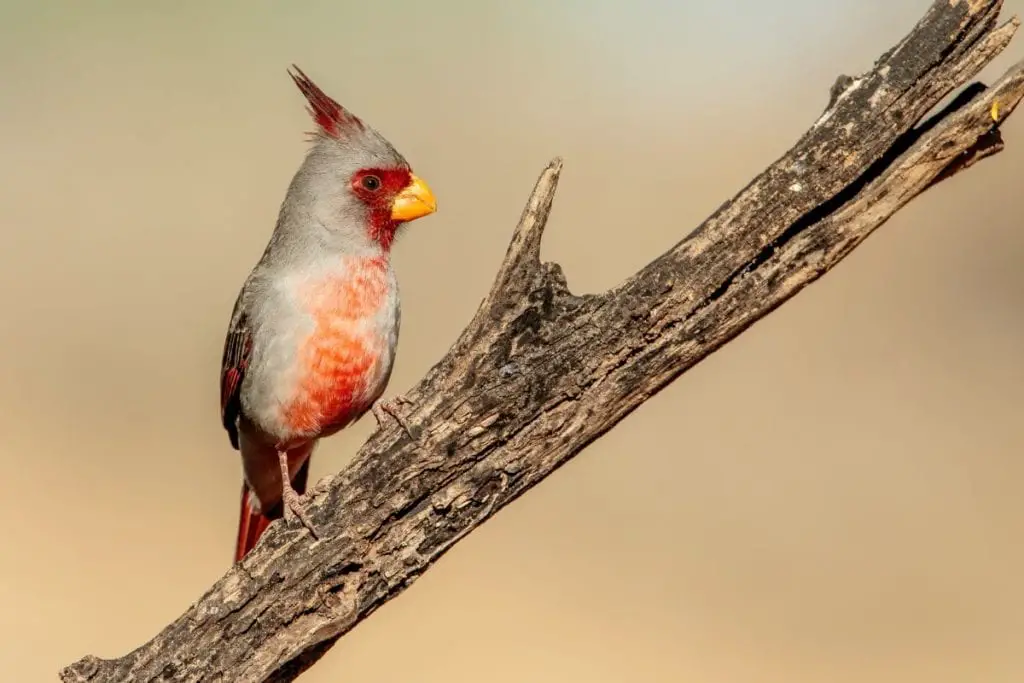
Pyrrhuloxias are wild creatures that are not traditionally kept as pets. These birds belong in the wild, and so it is not possible to legally get a pyrrhuloxia and keep it as a caged bird. In fact, if you come across a vendor offering you pyrrhuloxia for sale, you should immediately contact a conservation officer.
Although you cannot acquire a pyrrhuloxia in the sense of keeping it as a pet, it is fully possible to admire these colorful feathery fellows in their natural habitat.
Note that these birds are habitat specialists. Therefore, birders in the Southwest should look for desert cardinals in desert scrub. Mind that these birds do not only look but also sound like gray-and-red, crisp cardinals, and so mistaking the pyrrhuloxia for its close relative – the Northern cardinal, is quite often the case, especially among beginner bird watch enthusiasts.
In order to distinguish the Pyrrhuloxia from the Northern cardinal, as both bird species occur in the desert, stay on the watch for key distinguishing points, in particular, the Pyrrhuloxia’s long crest and the curved, short, yellow bill.
One can also get a closer glimpse of these beautiful creatures by attracting them to bird feeders, provided the bird watch enthusiast happens to reside in these birds’ natural range.
Interesting Facts
1. An individual Pyrrhuloxia has been reportedly spotted wandering quite far away from its dominant range, in particular, in Orange County, California.
2. It is possible for hybridization to occur among the Northern cardinal and the Desert cardinal when it comes to areas where these birds’ range overlaps.
3. The Pyrrhuloxia is a benefit to cotton fields, as this bird is known to feed on the harmful populations of weevils and cotton worms alike.
4. One of the desert cardinal’s songs is a clear and sharp sound described as a double “wha-cheer.” Another song is characterized as a metallic “quink” note. Apart from males, the females also sing, yet they use much duller softer notes. Additionally, both sexes give regular contact calls while foraging, described as a short “chip” or “cheep” note.
5. The common name for the desert cardinal – Pyrrhuloxia – was once a part of the bird’s scientific name. It is derived from the Greek term “πυρρος” (pyrrhos), meaning “reddish,” “orange,” or “flame-colored,” referring to this bird species’ coloration. Meanwhile, the Greek word “λοξος” (loxos) means “oblique” or “crooked,” referring to the shape of the pyrrhuloxia’s bill.
6. The other common name for the Pyrrhuloxia – Desert cardinal – is related to the habitat preferences of this bird species, known to most commonly occupy the arid regions in the American southwest.
7. In the wintertime, the foraging flocks of desert cardinals may reach as many as 1000 birds in number.
8. Not only are Pyrrhuloxias commonly mistaken for their close relative with whom they share the same genus – the Northern cardinal – but these species also share similar behaviors, as well as vocalizations. The Northern Cardinal is known to inhabit the same range as the Pyrrhulocia, although sharing a preference for wetter habitats.
Even though both the Pyrrhuloxia and the Northern Cardinal males alike will ferociously defend their breeding territories from members of their own species, when the Northern Cardinal’s and the Pyrrhuloxia’s territories overlap, these two bird species have not been observed to fight with each other.
9. Amazingly, Pyrrhuloxias seem to fulfill most of their water requirements by the insect food they consume in the spring and in the summertime. Whenever possible, though, these birds are known to gladly drink at pools of water.
10. A Pyrrhuloxia individual was reported to sit on a terrace, enjoying the cool air-conditioned breeze coming out of the house during an extremely hot day when the temperatures outside reached 118 degrees Fahrenheit. Moreover, this canny behavior has been observed in other bird species, in particular, Loggerhead shrikes and Cactus wrens.
11. Pyrrhuloxias may enjoy interacting with humans, and they can be even hand-fed!
How to Care for the Pyrrhuloxia
To take good care of the Pyrrhuloxia, birders who happen to reside in this bird species’ wintering regions in southwest North America can make excellent use of bird feeders.
Pyrrhuloxias often tend to readily come to backyards searching for seeds to feed with. They are particularly attracted to black oil sunflower seeds, cracked corn, and hulled sunflower seeds.
As a rule of thumb, these birds are much more likely to feed on ground feeders rather than visiting elevated types of feeders. Also, they will gladly feed on seeds that are scattered or discarded directly on the ground.
The suitable types of feeders to attract desert cardinals include large hopper, platform feeders, ground feeders, and large tube feeders.
Pyrrhuloxias may be also attracted to birdbaths.
Most importantly, it is the birder’s responsibility to maintain proper hygiene at the feeding area, including regular disinfection of the bird feeders and/or birdbaths, as well as making sure to provide only fresh, quality seeds. Moldy seeds can lead to disease in birds, and so can dirty bird feeders and birdbaths alike.
To properly clean the bird feeder/bird bath, dismantle the feeder and soak the parts in a diluted bleach solution for about 10 minutes for the best results. Rinse with clean, hot water, and allow the feeder to thoroughly dry before filling it with seeds.
Don’t forget to change the seeds on a daily basis, never leaving moldy seeds to hang in the bird feeder. Always opt for the highest quality seeds and check the inspiration date prior to feeding the birds. Also, make sure to store seeds the right way, in a cool, dark place, away from direct access to sunlight or damp conditions.
In the case of a disease outbreak, or if you frequently spot ill/dead birds in your backyard, you need to contact qualified professionals to help you out as soon as feasible. Do never touch dead or ill birds without wearing protective gear, as some diseases in birds may also cause illnesses in humans, too, as in the case of possible Salmonella infection.
The availability of native, fruit-bearing shrubs favored by the pyrrhuloxia, and nonetheless, fruit-bearing cacti in the birder’s backyard/garden, will certainly greatly increase the chances of getting visited by these colorful, canny feathery fellows.
Last but not least, it is worth to educate others about the invaluable role that each and every animal species, including the Pyrrhuloxia, plays when it comes to preserving the subtle, vital balance in Mother Nature’s ecosystems.
With the ongoing consequences of climate change, it becomes more important than ever to recognize and appreciate the beauty and intelligence encoded in all of the living creatures with whom we share planet Earth, as to be able to protect and successfully preserve the biodiversity of wildlife for the next generations.
FAQs
How Do You Say Pyrrhuloxia?
The common name for the desert cardinal – “Pyrrhuloxia” – is pronounced “pir-uh-lok-see-uh.”
What Does a Pyrrhuloxia Look like?
The male and female Pyrrhuloxias differ in color. The male Pyrrhuloxia is overall crisp gray-colored, with red splotches within the wings and a distinct reddish chest, as well as a red face mask that surrounds the crooked, yellow beak. The female Pyrrhuloxia is overall buff gray, and the red highlights that appear on the crest and wings are duller than in males, with the red face mask lacking.
Do Cardinals Live in the Desert?
Just like the very name suggests, the Desert Cardinal (C. sinuatus), aka Pyrrhuloxia, is known to dwell in North America’s more arid parts, primarily in the southern portion of New Mexico, parts of Texas, and the southern regions of Arizona. Sometimes, the desert cardinal’s range may overlap with the Northern cardinal’s range.
Are Desert Cardinals and Grosbeaks Related?
Yes, desert cardinals and grosbeaks are related as they share the same family, the family Cardinalidae. Cardinals, being passerine birds occupying South and North America, are also known as cardinal-grosbeaks.
What is the Spiritual Meaning of a Desert Cardinal?
The desert cardinal is a symbol of wealth, power, and welfare, and so the spiritual meaning of this bird is related to understanding better what one wants out of life, as well as how one can achieve what he/she dreams of. The desert cardinal is also seen as a spiritual messenger, and a spirit animal, driving one’s attention towards the importance of cherishing the spiritual connections that remain invisible to the eye and can only be felt with the heart.
How to Attract Pyrrhuloxias to your Garden or Backyard?
To attract Pyrrhuloxias to your garden or backyard, scatter black oil sunflower seeds, hulled sunflower seeds, and/or cracked corn directly on the ground or fill the seeds into ground type feeders, large tube feeders, or large hopper platform feeders. Also, you can use a birdbath to attract Pyrrhuloxias, as well as garden landscaping that makes use of native, fruit-bearing cacti and shrubs.
Is the Pyrrhuloxia Endangered?
No, the Pyrrhuloxia is not considered seriously endangered with extinction as of 2019. It is listed as Least Concern on the IUCN Red List of Threatened Species.

